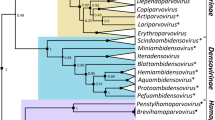Abstract
We have completed the analysis of a genomic clone, G238, that contains most of the coding region of the sponge COLF1 fibrillar collagen gene. The main triple helical domain is encoded by 31 exons. Except for the 5′ junction exon and the two last 3′ exons (126 and 18 base pairs), all these exons are related to a 54-bp unit and begin with an intact glycine codon. A good correlation can be made between this sponge gene and a vertebrate fibrillar collagen gene, revealing the high conservation of the members of this family during evolution. The reconstitution of an ancestral collagen gene can be made by considering all the exon/intron junctions of these genes. We suggest that such an ancestral gene arose from multiple duplications of a 54-bp exon and a (54 + 45)-bp module.
Similar content being viewed by others
Abbreviations
- bp:
-
base pair(s)
- kb:
-
kilobase(s)
- C-protease:
-
the enzyme that cleaves the carboxyl-terminal propeptide
References
Buttice G, Kaytes P, d'Armiento J, Vogeli G, Kurkinen M (1990) Evolution of collagen IV genes from a 54-base pair exon: a role for introns in gene evolution. J Mol Evol 30: 479–488
D'Alessio M, Ramirez F, Suzuki H, Solursh M, Gambino R (1989) Structure and developmental expression of a sea urchin fibrillar collagen gene. Proc Natl Acad Sci USA 86: 9303–9307
Dardel F, Bensoussan P (1988) DNAid: A Macintosh full screen editor featuring a built-in regular expression interpreter for the search of specific patterns in biological sequences using finite state automata. Cabins 4: 483–486
de Wet W, Bernard M, Benson-Chanda V, Chu ML, Dickson L, Weil D, Ramirez F (1987) Organization of the human pro-α2(I) collagen gene. J Biol Chem 262: 16032–16036
Doolittle WF (1978) Genes in pieces: were they ever together? Nature 272: 581–582
Exposito JY, Garrone R (1990) Characterization of a fibrillar collagen gene in sponges reveals the early evolutionary appearance of two collagen gene families. Proc Natl Acad Sci USA 87: 6669–6673
Exposito JY, Ouazana R, Garrone R (1990) Cloning and sequencing of a Porifera partial cDNA coding for a short-chain collagen. Eur J Biochem 190: 401–406
Exposito JY, Le Guellec D, Lu Q, Garrone R (1991) Short chain collagens in sponges are encoded by a family of closely related genes. J Biol Chem 266: 21923–21928
Exposito JY, D'Alessio M, Solursh M, Ramirez F (1992a) Sea urchin collagen evolutionarily homologous to vertebrate proα2(I) collagen. J Biol Chem 267: 15559–15562
Exposito JY, D'Alessio M, Ramirez F (1992b) Novel amino-terminal propeptide configuration in a fibrillar procollagen undergoing alternative splicing. J Biol Chem 267: 17404–17408
Eyre DR, Paz MA, Gallop PM (1984) Cross-linking in collagen and elastin. Annu Rev Biochem 53: 717–748
Gail F, Wiedemann H, Mann K, Kühn K, Timpl R, Engel J (1991) Molecular characterization of cuticle and interstitial collagens from worms collected at deep sea hydrothermal vents. J Mol Biol 220: 209–223
Gilbert W, Marchionni M, McKnight G (1986) On the antiquity of introns. Cell 46: 151–154
Giudice GJ, Squiquera HL, Elias PM, Diaz LA (1991) Identification of two collagen domains within the bullous pemphigoid autoantigen, BP 180. J Clin Invest 87: 734–738
Kodama T, Freeman M, Rohrer L, Zabrecky J, Matsudaira P, Krieger M (1990) Type I macrophage scavenger receptor contains α-helical and collagen-like coiled coils. Nature London 343: 531–535
Kuivaniemi H, Tromp G, Prockop DJ (1991) Mutations in collagen genes: causes of rare and some common diseases in humans. FASEB J 5: 2052–2060
Marchant JK, Linsenmayer TF, Gordon MK (1991) cDNA analysis predicts a cornea-specific collagen. Proc Natl Acad Sci USA 88: 1560–1564
Mayne R, Burgeson RE (1987) Structure and function of collagen types. Academic Press, Orlando
Padgett RA, Grabowski PJ, Konarska MM, Seilers S, Sharp PA (1986) Splicing of messenger RNA precursors. Ann Rev Biochem 55: 1119–1150
Pan TC, Zhang RZ, Mattei MG, Timpl R, Chu ML (1992) Cloning and chromosomal location of human α1(XVI) collagen. Proc Natl Acad Sci USA 89: 6565–6569
Sanger F, Nicklen S, Coulson AR (1977) DNA sequencing with chain terminating inhibitors. Proc Natl Acad Sci USA 74: 5463–5467
Shih MC, Heinrich P, Goodman HM (1988) Intron existence predated the divergence of eukaryotes and prokaryotes. Science 242: 1164–1166
Su MW, Benson-Chanda V, Vissing H, Ramirez F (1989) Organization of the exons coding for proα1(II) collagen N-propeptide confirms a distinct evolutionary history of this domain of the fibrillar collagen genes. Genomics 4: 438–441
Su MW, Suzuki MR, Bieker JJ, Solursh M, Ramirez F (1991) Expression of two nonallelic type II procollagen genes during Xenopus laevis embryogenesis is characterized by stagespecific production of alternatively spliced transcripts. J Cell Biol 115: 565–575
van der Rest M, Garrone R (1991) Collagen family of proteins. FASEB J 5: 2814–2823
Vuorio E, de Crombrugghe B (1990) The family of collagen genes. Annu Rev Biochem 59: 837–872
Wozney J, Hanahan D, Tate V, Boedtker H, Doty P (1981) Structure of the proα2(I) collagen gene. Nature 294: 129–135
Yamada Y, Avvedimento VE, Mudryj M, Ohkubo H, Vogeli G, Irani M, Pastan I, de Crombrugghe B (1980) The collagen gene: evidence for its evolutionary assembly by amplification of a DNA segment containing an exon of 54 bases. Cell 22: 887–893
Zagursky RJ, Berman ML, Baumeister K, Lomax N (1986) Rapid and easy sequencing of large linear double stranded DNA and supercoiled plasmid DNA. Gene Anal Tech 2: 232–238
Author information
Authors and Affiliations
Rights and permissions
About this article
Cite this article
Exposito, JY., van der Rest, M. & Garrone, R. The complete intron/exon structure of Ephydatia mülleri fibrillar collagen gene suggests a mechanism for the evolution of an ancestral gene module. J Mol Evol 37, 254–259 (1993). https://doi.org/10.1007/BF00175502
Received:
Accepted:
Issue Date:
DOI: https://doi.org/10.1007/BF00175502




